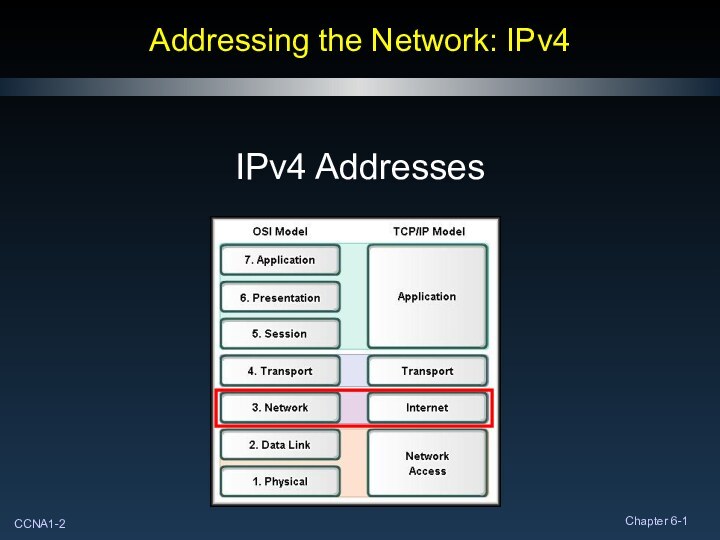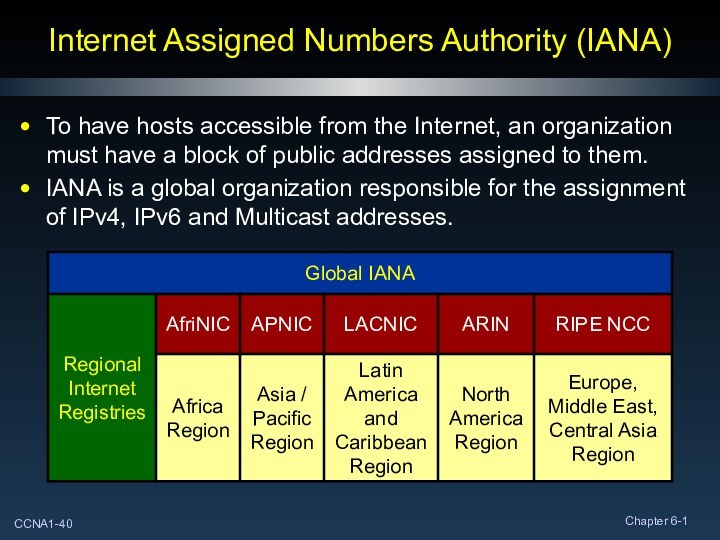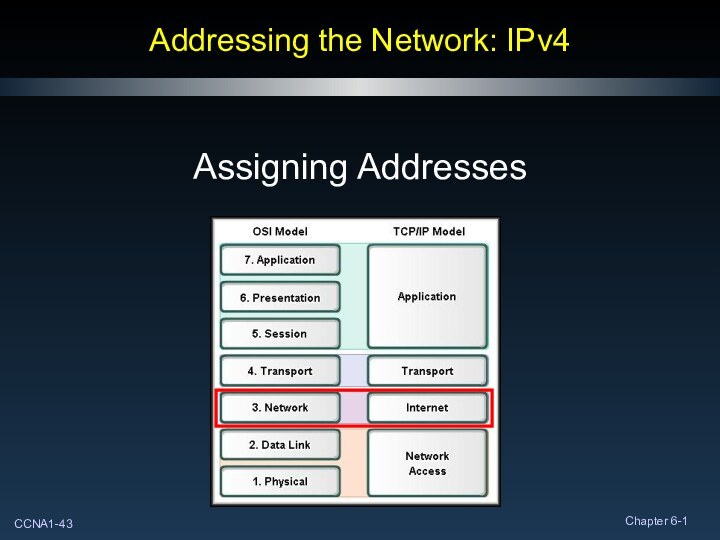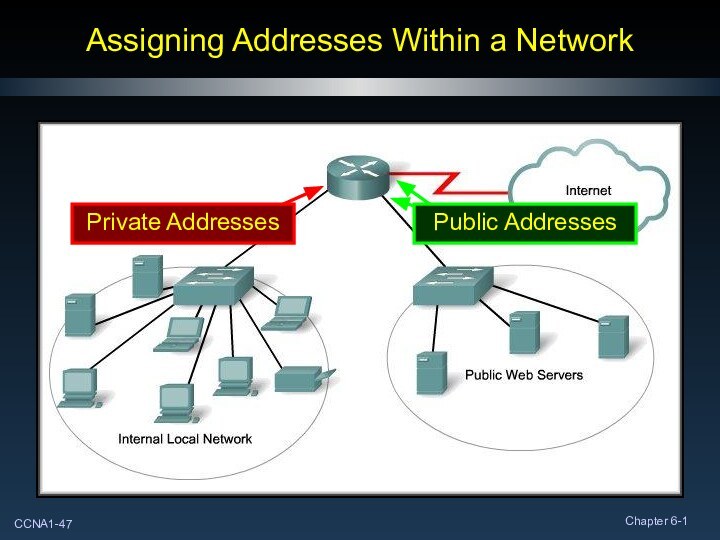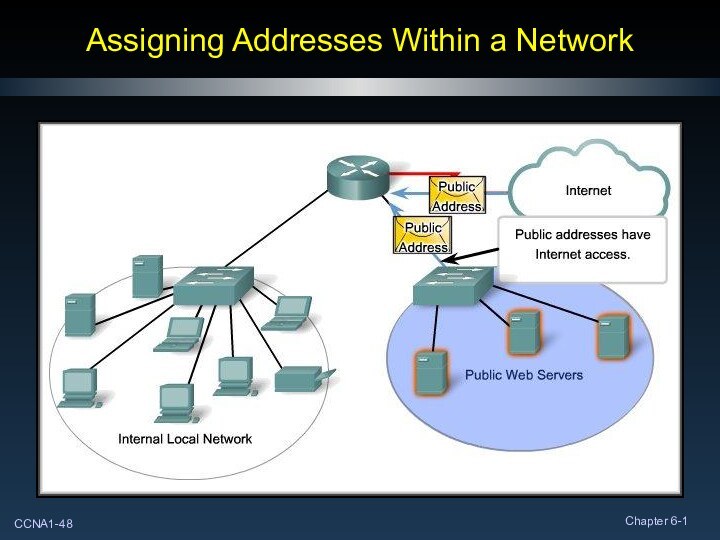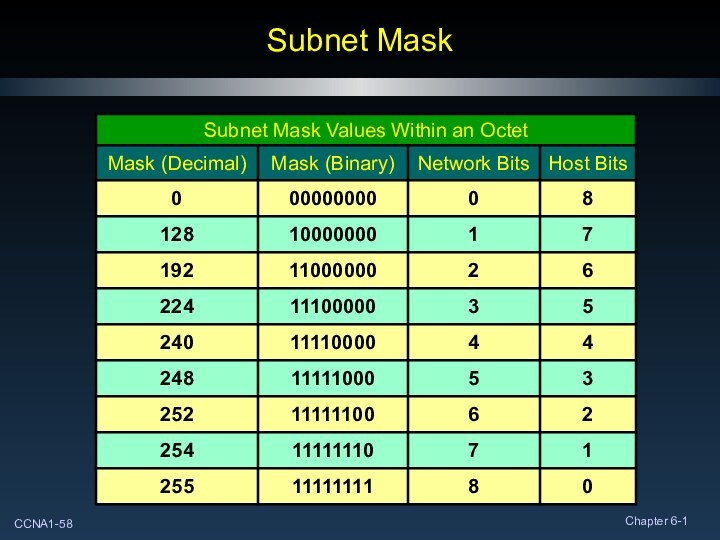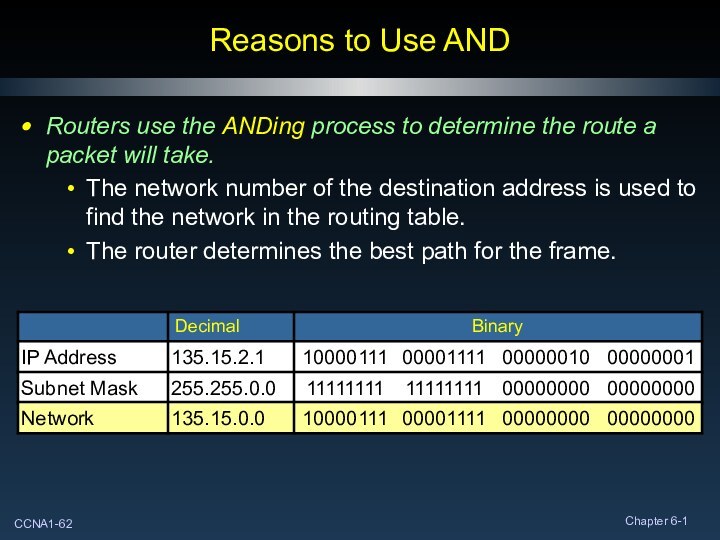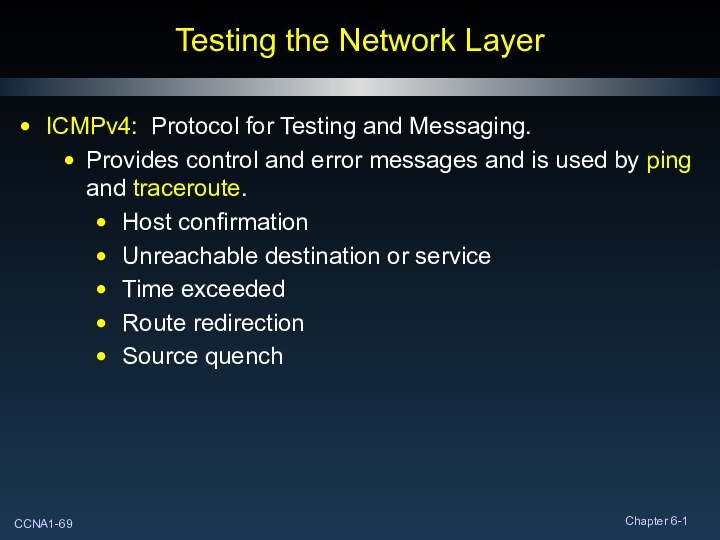Слайд 2
Addressing the Network: IPv4
IPv4 Addresses
Слайд 3
Anatomy of an IPv4 Address
Each device on a
network must be uniquely identified at the Network layer.
For
IPv4, a 32 bit source and destination address is contained in each packet.
Слайд 4
Anatomy of an IPv4 Address
Devices use binary logic
and work with strings of binary numbers. For us,
the decimal equivalent is much easier to use and remember.
Expressed in DOTTED DECIMAL NOTATION
Слайд 5
Anatomy of an IPv4 Address
To identify a path
or "route" through a network, the address
must be composed
of two parts:
Network portion
Host portion
1.1
1.2
1.3
2.1
2.2
3.1
3.2
Слайд 6
Anatomy of an IPv4 Address
Network Portion:
Some portion of
the high-order bits represents the network address.
At Layer 3,
we define a network as a group of hosts that have identical bit patterns in the network address portion of their addresses.
Слайд 7
Anatomy of an IPv4 Address
Host Portion:
There are a
variable number of bits that are called the host
portion of the address.
The number of bits used in this host portion determines the number of hosts that we can have within the network.
Слайд 8
Binary to Decimal Conversion
In all number systems, the
digits start with 0.
A Base-n number system has n
number of digits:
Decimal:
Base-10 has 10 digits
9, 8, 7, 6, 5, 4, 3, 2, 1, 0
Binary:
Base-2 has 2 digits
1, 0
Hexadecimal:
Base-16 has 16 digits
F, E, D, C, B, A, 9, 8, 7, 6, 5, 4, 3, 2, 1, 0
Слайд 9
Binary to Decimal Conversion
Positional Notation (Decimal Number System):
Means
that a digit represents different values depending on the
position it occupies.
The value that a digit represents is that value multiplied by the power of the base according to the position the digit occupies.
(2x103) + (1x102) + (3x101) + (4x100) = 2,134
Слайд 10
Binary to Decimal Conversion
Computers react only to electrical
impulses.
They work with and store data using electronic switches
that are either on (1) or off (0).
They can only understand and use data that is in this two state format.
These 1's and 0's are called binary digits or bits.
Слайд 11
Binary to Decimal Conversion
Positional Notation (Binary Number System):
Means
that a digit represents different values depending on the
position it occupies.
The value that a digit represents is that value multiplied by the power of the base according to the position the digit occupies.
(1x26) + (1x25) + (1x23) + (1x22)
64 + 32 + 8 + 4 = 108
Слайд 13
Binary to Decimal Conversion
IP Address: 11001001000100010001110100000100
11001001
00010001
00000100
00011101
201
17
29
4
IP Address:
201.17.29.4
Слайд 15
Decimal to Binary Conversion
IP Address: 201.17.29.4
201
1
0
0
1
1
Слайд 16
Decimal to Binary Conversion
IP Address: 201.17.29.4
17
Слайд 17
Decimal to Binary Conversion
IP Address: 201.17.29.4
29
1
1
Слайд 18
Decimal to Binary Conversion
IP Address: 201.17.29.4
4
Binary String:
110001001000100010001110100000100
Слайд 20
Addressing the Network: IPv4
IPv4 Addresses for Different Purposes
Слайд 21
Types of Addresses in an IPv4 Network Range
Three
types:
Network and Broadcast addresses
CANNOT
be assigned to a host.
Слайд 22
Network Address
Standard way to reference a network (Lowest
Address).
All hosts in the network will have the same
network bits.
Cannot be assigned to a device.
Each host bit in this address will be 0.
Слайд 23
Broadcast Address
The destination address of a single packet
used to communicate to all hosts in a network
(Highest Address)
Cannot be assigned to a device.
Each host bit in this address will be 1.
Слайд 24
Host Address
The unique address assigned to each device
on the network.
Assign any address between the network address
(192.168.10.0) and the broadcast address (192.168.10.255).
Addresses 192.168.10.1 through 192.168.10.254.
Слайд 25
Types of Communication in an IPv4 Network
Three
types:
In all three types, the address of the originating
host is used as the source address in the packet.
Слайд 26
Unicast Communications
The process of sending a packet from
one host to an individual host.
Слайд 27
Special Unicast Addresses
Default Route:
Address - 0.0.0.0
Subnet Mask – 0.0.0.0
When configured, it tells the
device….
If you don’t know where to send the frame, send it here.
Слайд 28
Special Unicast Addresses
Loopback:
Address - 127.0.0.1
Host applications use it
to communicate with each other.
Test TCP/IP configuration on a
PC – ping 127.0.0.1
Слайд 29
Special Unicast Addresses
Link Local Addresses:
Address Range 169.254.0.0 to
169.254.255.255
Can be automatically assigned by the operating system where
no IP configuration is available.
Слайд 30
Special Unicast Addresses
Test-Net Addresses:
Address Range 192.0.2.0 to 192.0.2.255
Used
for teaching and learning purposes.
Appear in documentation and network
examples.
Will be accepted by a network device.
Used to provide examples in RFCs and vendor and protocol documentation.
Should not appear on the Internet.
Your best bet…..
STAY AWAY FROM THEM….
Слайд 31
Special Unicast Addresses
Experimental Address Range:
Address Range 240.0.0.0 to
255.255.255.254
Reserved for future use.
Cannot be used on IPv4 networks.
Used
for research and experimentation.
Слайд 32
Special Unicast Addresses
Public and Private Addresses:
Most IPv4 addresses
are public addresses.
A public address is one that is
designated for use in networks that are accessible on the Internet.
Networks that require limited or no Internet access, use private addresses.
Private addresses are assigned from blocks of private address space set aside for that purpose.
10.0.0.0/8 (10.0.0.0 to 10.255.255.255)
172.16.0.0/12 (172.16.0.0 to 172.31.255.255)
192.168.0.0/16 (192.168.0.0 to 192.168.255.255)
Слайд 33
Broadcast Communications
The process of sending a packet from
one host to all hosts in the network.
Слайд 34
Broadcast Communications
Broadcasts are not forwarded by a router
unless specifically
configured to do so.
The bits in the host
portion of a broadcast address will be
all 1s.
Слайд 35
Multicast Communications
The process of sending a packet from
one host to a selected group of hosts.
Слайд 36
Multicast Communications
Multicasting involves the use
of a reserved network
of
IP Addresses (224.0.0.0).
Each host that is to
participate in a
multicast
session first joins the
multicast group controlled by
the router.
When the packet from the
source arrives at the router,
it is forwarded to all members of the multicast group.
Слайд 37
Multicast Communications
The reserved multicast network or specific multicast
addresses will be displayed in the routing table of
a device.
The following is from a PC.
Слайд 38
Reserved and Special Purpose Addresses
Слайд 39
Addressing the Network: IPv4
IANA and ISPs
Слайд 40
Internet Assigned Numbers Authority (IANA)
To have hosts accessible
from the Internet, an organization must have a block
of public addresses assigned to them.
IANA is a global organization responsible for the assignment of IPv4, IPv6 and Multicast addresses.
Слайд 41
Internet Service Provider (ISP)
Most companies or organizations obtain
their IPv4 address blocks from an ISP.
The ISP loans
or rents these addresses to the organization.
If we move our Internet connectivity, the new ISP will provide us with addresses from the address blocks that have been provided to them.
Our previous ISP will loan the returned addresses to other customers.
ISPs have their own set of internal data networks to manage Internet connectivity and to provide related services (DNS, e-mail, website).
Слайд 42
Internet Service Provider (ISP)
ISPs are designated by a
hierarchy based on their level of connectivity to the
Internet backbone.
Слайд 43
Addressing the Network: IPv4
Assigning Addresses
Слайд 44
Planning to Address the Network
Planning and documentation is
an important part of
IP Address assignment.
Preventing duplication of addresses.
Each
host on a network MUST have a unique address.
Providing and controlling access.
Some servers provide services for both internal and external users.
Filters and access control can be done at Layer 3.
Monitoring security and performance.
Examining network traffic and troubleshooting requires a good knowledge of the addressing scheme.
Слайд 45
Assigning Addresses Within a Network
The IP Addresses for
hosts on a common network segment must all have
the same network portion.
Desktop Workstations
Laptops
Internal Servers
External Internet Servers
Printers
Routers
Switches
Each of these should be assigned a logical block of addresses within the address range of the network.
Слайд 46
Assigning Addresses Within a Network
Considerations – Private and
Public addresses.
Will there be more devices connected to the
network than public addresses allocated by the network's ISP?
Will the devices need to be accessed from outside the local network?
If devices that may be assigned private addresses require access to the Internet, is the network capable of providing a Network Address Translation (NAT) service?
Слайд 47
Assigning Addresses Within a Network
Слайд 48
Assigning Addresses Within a Network
Слайд 49
Assigning Addresses Within a Network
Слайд 50
Static or Dynamic Addressing
Static Address Assignment
Слайд 51
Static or Dynamic Addressing
Dynamic Address Assignment - DHCP
Слайд 53
Addressing the Network: IPv4
IPv4 Addresses
Prefix and Subnet Mask
Слайд 54
Network Prefixes
How do you know the number of
bits assigned to the network and the number of
bits assigned to the host?
Prefix Mask:
The address is followed by a number that represents the number of bits (prefix length), beginning from the left, that apply to the network.
A slash (/) is used to separate the address and the prefix length.
192.168.10.2/24
Means that the first 24 bits are the network portion.
The last 8 bits are the host portion.
Слайд 55
Network Prefixes
Networks are not always assigned a /24
prefix.
Depending on the number of hosts on the network,
the prefix can be different.
Having a different prefix changes the host range and the broadcast address.
Слайд 56
Subnet Mask
How do the network devices know how
many bits are the network portion and how many
bits are the host portion?
Subnet Mask:
A 32 bit value, expressed in dotted decimal notation, that specifies the number of network bits and the number of host bits.
The Prefix Mask and the Subnet Mask are different ways of representing the same information.
Prefix Mask of /24 or a subnet mask of 255.255.255.0
First 24 bits are the network portion.
The remaining 8 bits are the host portion.
Слайд 57
Subnet Mask
There is a direct, one-to-one relationship between
the bits of the IP Address and the bits
of the subnet mask.
The subnet mask uses 1 and 0 bits to indicate that the corresponding bit of the IP address is either the
network (1) or the host (0) portion.
IP Address: 172.16.4.35 / 24
Слайд 59
Subnet Mask
IP Address: 10.24.36.2 / 8
Subnet Mask?
IP Address: 10.24.36.2 / 12
Subnet Mask?
IP Address: 10.24.36.2 / 16 Subnet Mask?
IP Address: 10.24.36.2 / 23 Subnet Mask?
IP Address: 10.24.36.2 255.255.224.0 Prefix Mask?
IP Address: 10.24.36.2 255.255.255.192 Prefix Mask?
IP Address: 10.24.36.2 255.255.255.252 Prefix Mask?
IP Address: 10.24.36.2 255.254.0.0 Prefix Mask?
IP Address: 10.24.36.2 255.255.240.0 Prefix Mask?
Слайд 60
Is the Host on My Network?
To send a
broadcast, a network device must be able to divide
the IP Address into the network and host portion.
It uses a process called ANDing.
The IP Address is converted to binary.
The Binary AND Truth Table is used to compare the bits strings of the address with the subnet mask.
Слайд 61
Is the Host on My Network?
IP Address 135.15.2.1
255.255.0.0
Слайд 62
Reasons to Use AND
Routers use the ANDing process
to determine the route a packet will take.
The network
number of the destination address is used to find the network in the routing table.
The router determines the best path for the frame.
Слайд 63
Reasons to Use AND
The source device uses the
ANDing process to determine if the packet is to
be sent to the default gateway.
A PC will use it to determine the destination network.
If the destination network is the same as the network where the PC resides, the packet is sent directly to that host.
If the destination network is different, the packet is sent to the default gateway.
Слайд 64
Addressing the Network: IPv4
Testing the Network Layer
Слайд 67
Testing the Network Layer
C:>ping 10.0.1.2
Слайд 69
Testing the Network Layer
ICMPv4: Protocol for Testing and
Messaging.
Provides control and error messages and is used by
ping and traceroute.
Host confirmation
Unreachable destination or service
Time exceeded
Route redirection
Source quench

